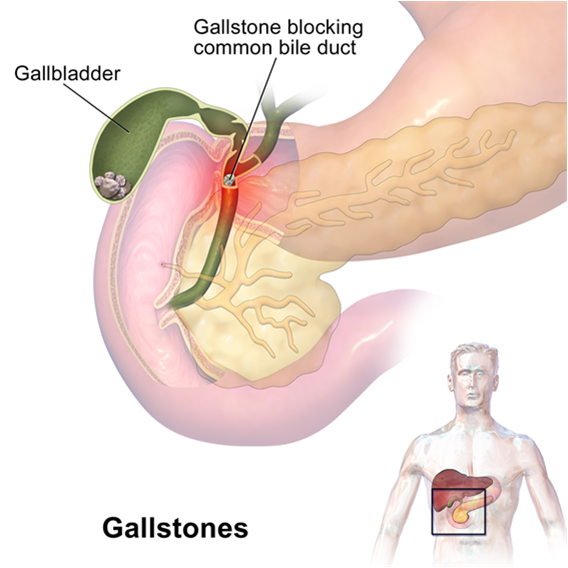- 2094, Dividing Rd, Phase 2, Urban Estate Dugri, Ludhiana
- +91 8872036060
- harpaldr@yahoo.com
Gallstones Clinic
Gallstones are hard particles that develop in the gallbladder. The gallbladder is a small, pear-shaped organ located in the upper right abdomen Gallstones can range in size from a grain of sand to a golf ball. The gallbladder can develop a single large gallstone, hundreds of tiny stones, or both small and large stones.
What is the biliary tract?The biliary tract consists of the gallbladder and the bile ducts. The bile ducts carry bile and other digestive enzymes from the liver and pancreas to the duodenum—the first part of the small intestine.
The Biliary Tract:
The bile ducts of the biliary tract include the hepatic ducts, the common bile duct, the pancreatic duct, and the cystic duct. The gallbladder stores bile. Eating signals the gallbladder to contract and empty bile through the cystic duct and common bile duct into the duodenum to mix with food.
Imbalances in the substances that make up bile cause gallstones. Gallstones may form if bile contains too much cholesterol, too much bilirubin, or not enough bile salts. The two types of gallstones are cholesterol and pigment stones:
• Cholesterol stones, usually yellow-green in color, consist primarily of hardened cholesterol. In the United States, more than 80 percent of gallstones are cholesterol stones
• Pigment stones, dark in color, are made of bilirubin.
- Women are more likely to develop gallstones than men. Extra estrogen can increase cholesterol levels in bile and decrease gallbladder contractions, which may cause gallstones to form. Women may have extra estrogen due to pregnancy, hormone replacement therapy, or birth control pills.
- People over age 40 are more likely to develop gallstones than younger people.
- American Indians have genetic factors that increase the amount of cholesterol in their bile. In fact, American Indians have the highest rate of gallstones in the United States—almost 65 percent of women and 30 percent of men have gallstones. Other factors that affect a person’s risk of gallstones include2
- Obesity
- Rapid weight loss
- High Calorie low fibre diet
- Certain intestinal diseases
- Metabolic syndrome, diabetes, and insulin resistance Pigment stones tend to develop in people who have
- cirrhosis—a condition in which the liver slowly deteriorates and malfunctions due to chronic, or long lasting, injury
- infections in the bile ducts
- severe hemolytic anemias—conditions in which red blood cells are continuously broken down, such as sickle cell anemia
Many people with gallstones do not have symptoms. Gallstones that do not cause symptoms are called asymptomatic, or silent, gallstones. Silent gallstones do not interfere with the function of the gallbladder, liver, or pancreas. If gallstones block the bile ducts, pressure increases in the gallbladder, causing a gallbladder attack. The pain usually lasts from 1 to several hours.1 Gallbladder attacks often follow heavy meals, and they usually occur in the evening or during the night. Gallbladder attacks usually stop when gallstones move and no longer block the bile ducts. However, if any of the bile ducts remain blocked for more than a few hours, complications can occur. Complications include inflammation, or swelling, of the gallbladder and severe damage or infection of the gallbladder, bile ducts, or liver. A gallstone that becomes lodged in the common bile duct near the duodenum and blocks the pancreatic duct can cause gallstone pancreatitis—inflammation of the pancreas. Left untreated, blockages of the bile ducts or pancreatic duct can be fatal.
When should a person talk with a health care provider about gallstones?People with any of the following symptoms during or after a gallbladder attack should see a health care provider immediately:
- abdominal pain lasting more than 5 hours
- nausea and vomiting
- fever—even a low-grade fever—or chills
- yellowish color of the skin or whites of the eyes, called jaundice
- tea-colored urine and light-colored stools
- Ultrasound exam - Ultrasound is the most accurate method to detect gallstones.
- Magnetic resonance imaging (MRI) - MRIs can show gallstones and stones slipped in the ducts of the biliary system.
- Computerized tomography (CT) scan - CT scans can show gallstones or complications, such as infection and blockage of the gallbladder or bile ducts. However, CT scans can miss gallstones that are present.
- Liver function tests
If gallstones are not causing symptoms, treatment is usually not needed. However, if a person has a gallbladder attack or other symptoms, then it needs treatment. If a person has had one gallbladder attack, more episodes will likely follow. The usual treatment for gallstones is surgery to remove the gallbladder called cholecystectomy.. ERCP is sometimes required if there is a stone in the biliary system.



